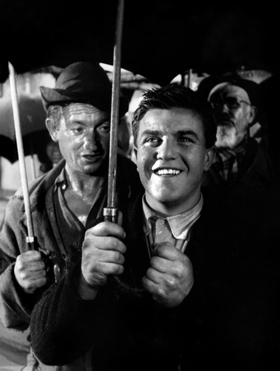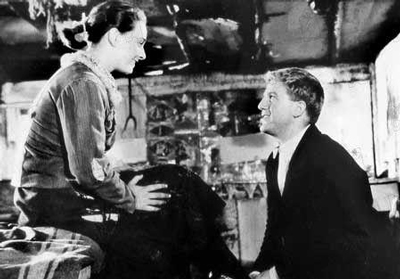
 |
|
|
|
Toward the end of the era of Italian Neorealism, after most of the classics had made their impression world-wide -- Ossessione, Roma Città aperta, Sciuscià, Paisà, Ladri di biciclette, Stromboli -- top actor-turned director Vittorio De Sica produced and directed something entirely different. Neorealism would adapt itself to newer forms, and traces of the approach have certainly persisted. Its influence would be felt in films everywhere. But few outright fantasy pictures successfully incorporated the trend's social commentary on the plight of the common man in harsh moral and economic times. 
De Sica's 1951 Miracle in Milan (MIracolo a Milano) takes place in a familiar Neorealist setting, an Italian city still recovering from the war. But instead of a realistic social document, it's an outright fantasy, a Film Blanc in which magic exists, along with angelic visitations from a magical afterlife. Yet this film blanc, while celebrating the simple pleasures of people forming a community and "getting along", takes a backhanded swipe at unfettered Capitalism. And it makes much more of an impact than the average outraged social comment film, even those by the 'committed' Italian directors. De Sica's film, written by himself and Suso Cecchi D'Amico, Mario Chiari, Adolfo Franci and Cesare Zavattini, is a simple fable overflowing with good will toward men. C'era una volta ..." reads the first title: Once Upon a Time. A dotty old lady named Lolotta (Emma Gramatica, born in 1874) finds a baby in the cabbage patch, names him "Totó il buono" (The good Totó) and raises him to be cheerful, friendly and open to the wonders of the world. Lolotta passes away when Totó is still a child. Years later, on his release from the orphanage, Totó (Francesco Golisano) befriends a thief who tries to steal from him. He helps inspire a group of freezing homeless people to build a shanty town in an undeveloped field. A friendly, honest and open hearted diplomat, Totó smoothes over disputes. A statue of a beautiful woman is claimed by various men, but Totó encourages it to be erected in the "town square". Totó befriends Edvige (Brunella Bovo of Fellini's The White Sheik), a sweet, simpleminded servant to an indigent couple who still consider themselves socially superior. Only the curmudgeonly, selfish Rappi (Paolo Stoppa) refuses to join in the communal spirit. Trouble comes when the bigwig developer Mobbi (Guglielmo Barnabò) buys the field from another speculator. Mobbi pretends to be the squatters' friend, while actually preparing his private security force (in surplus German halftrack trucks) to evict them by force. But the soldiers don't count on the deceased Lolotta, who flies down from the sky to give Totó a magic dove that grants wishes. Totó is soon dispensing foolish consumer gifts to all that demand them -- fur coats, crystal chandeliers. He even brings the statue to life (Alba Amova) at the suggestion of an unhappy, unloved friend. And when the Army invades, Totó uses the dove's magic to defend the squatter's camp. Pursuing the angelic Lolotta are a pair of heavenly messengers, determined to retrieve the dove. Unique as it is, Miracle in Milan plays in a tone somewhat similar to Charlie Chaplin's Modern Times, with the same socialist message but without the star focus. Charlie accidentally picks up a red flag and becomes the leader of a labor demonstration; Miracle in Milan saves its jokes for its many amusing personalities, and lets the "message" soak in from context. The forever cheerful Totó engages with the cold world the way his Lolotta taught him, by simply saying "Good morning!" to people. Like Chaplin, he tells a despairing friend to buck up and to have courage -- despite their situation, he insists that the world is a beautiful place. Totó contains the innocence of Chaplin without the Little Tramp's mischievous streak. When his belongings are stolen, he commiserates with the sad thief and ends up splitting his possessions with him. A critic could say he's less human because he has no faults, except perhaps gullibility. The venal Mobbi uses populist babble to claim solidarity with the squatters: the developer claims that the poor can trust him because he has five fingers, just like they do. But Totó's utter goodness touches us. He's a pure soul incapable of deceit or lies. He has the common good at heart, and makes little personal sacrifices to help his peers. Totó empathizes with everyone. He squints when talking to a one-eyed man, and stoops when talking to a short man. His "meet cute" with the waifish Edvige has him defending her when she spills water on him. "I like it!" he says, spilling some more on himself to prove the point. Not the brightest girl in the world, Edvige fetches a bucket and gives Totó a good dousing. She smiles proudly, figuring that he should really be happy now. 
The most "socialist" that Miracle in Milan gets is when the squatters go on parade in their completed shanty town, singing the film's cheerful, catchy theme song. The lyrics express their basic need: "We want a place to sleep in / Where we can lay our heads..." Although never officially crowned, Totó is the cheerleader for the little society of good will. Miracle in Milan abounds with mysterious imagery even before the outright magic begins. When a small patch of sunlight breaks through the cold clouds, the freezing poor rush together to soak it up. Only Rappi tries to push his neighbors out of the warm light. In another odd scene, a lady sells tickets to sit in some chairs she's set up, to watch the setting sun. Gathered as an official paying audience, the group feels a communal lift in spirits at the pretty sight, and applauds the finale as the sun dips below the horizon. The scene is worth discussion. Is it a comment on simple pleasures, an analysis of the theatrical experience, or a critique of creeping commercialization? De Sica and his writers milk plenty of slapstick laughs from the maladroit efforts of Mobbi's private army to dislodge the squatters. But the introduction of the magic dove is more complicated than it sounds. Strategic miracles neutralize the attackers' smoke bombs and water cannons, and eventually send the army fleeing in panic. But the gifts of the dove also result in the poor behaving like their bourgeois betters - given the opportunity to do so, they also worship consumer goods and fancy clothing. Edvige's boss Marta appears in flowing furs, and immediately behaves in regal manner. Meanwhile, Totó flubs Edvige's wish. All she wants is a pair of real shoes, but her prospective boyfriend never gets beyond shoe number one. The Pygmalion-like transformation of the female statue doesn't solve any problems either. She dances and prances but seems to have no romantic inclinations, not even for the lonesome fellow who wanted her to come to life. "I want to go to the big city!" she keeps saying, perhaps convinced that she doesn't belong in this rat-trap. One episode is still puzzling, or doesn't communicate what it intends to. Totó notices a white woman and a black man who are attracted to each other, but both behave as if ashamed of their desires. If the idea that human lives are more important that property rights isn't "outrageous" enough, this racial subplot guarantees that Miracle in Milan would be refused wide exhibition in the United States of 1951. Both of the would-be-lovers ask Totó for a wish, which he is happy to grant -- but the subplot is dropped after a terrible mistake. (no spoilers here) From this vantage point 61 years removed, we're not sure of the point of this episode -- are the Italian authors as racially unenlightened as the scene makes them out to be? 
At this point Miracle in Milan begins conjure conflicting emotions. We know that stories about magic wishes usually end with harsh morals. We also do not see any acceptable way out for Totó and his hundreds of impoverished homeless, all just seeking to survive in a world that would prefer if the poor just disappeared somewhere. I'm not giving the ending away, although any synopsis could spoil Miracle in Milan for the prospective viewer. There is no good solution to this problem, which essentially describes the universal human condition, where appalling poverty exists next to balkanized developments guarded with machine guns. Showing a moral victory for the squatters, or even a compromise, would simply be false, a betrayal of reality. The film's chosen finale is simultaneously enchanting, depressing, exhilarating and as cruelly satirical as a Modest Proposal by Jonathan Swift. After watching decades' worth of "liberal cause" and/or "socially responsible" entertainment, I have yet to see anything as simple or as profound. Arrow Academy's Region B (not for domestic players) Blu-ray of Miracle in Milan far outpaces the old Criterion laserdisc version, where I first caught up with the film in 1991 or so. Author James Ursini sang the film's praises and I wasn't let down, although the worn Criterion source had a jump-cut splice that appeared to truncate a scene. This new Arrow Blu-ray has no breaks yet reveals no significant new material -- the splice must only have looked like a jump-cut. The HD transfer reflects a major restoration which makes Miracle in Milan look like it was filmed and recorded yesterday. The clear cinematography indeed reveals miracles: the sight of the baby Totó howling in the cabbage patch; Brunella Bovo's beaming smile; the simple but effective special effects of imported American "trick film" artist Ned Mann, of many Alexander Korda films including Things to Come. Alexandro Cicognini's catchy music score often has a circusy feel, yet is distinct from the sentimental tunes of Nino Rota. Designer-writer Mario Chiari also handled wardrobe -- Miracle in Milan is an exceptional picture from any given angle. Savant received his screener as a standalone disc without packaging. The Arrow English BD release comes with interviews with actress Brunella Bovo and the director's son Manuel De Sica, an interesting newsreel promoting the film's premiere, and a cute original trailer "hosted" by Francesco Golisano as Totó. Also included in store-bought copies is a second DVD disc containing a scarce De Sica film from 1956 called Il tetto (The Roof). Also written by Zavattini, it is reportedly about a similar situation, in which a homeless couple seeks to put a roof on their illegal house, because a law prevents the eviction of squatters from buildings with roofs! I also didn't get to see Arrow's booklet, which contains essays, stills and artwork referring to both movies. The company's published extras on earlier discs have been of a high quality. A search to see what other pictures the talented Francesco Golisano appeared in led to a sad discovery. The charming actor was killed in an auto accident just a few years later, at age 29.
On a scale of Excellent, Good, Fair, and Poor,
Miracle in Milan Blu-ray rates:
Reviews on the Savant main site have additional credits information and are often updated and annotated with reader input and graphics. Also, don't forget the 2011 Savant Wish List. T'was Ever Thus.
Review Staff | About DVD Talk | Newsletter Subscribe | Join DVD Talk Forum |
| ||||||||||||||||||